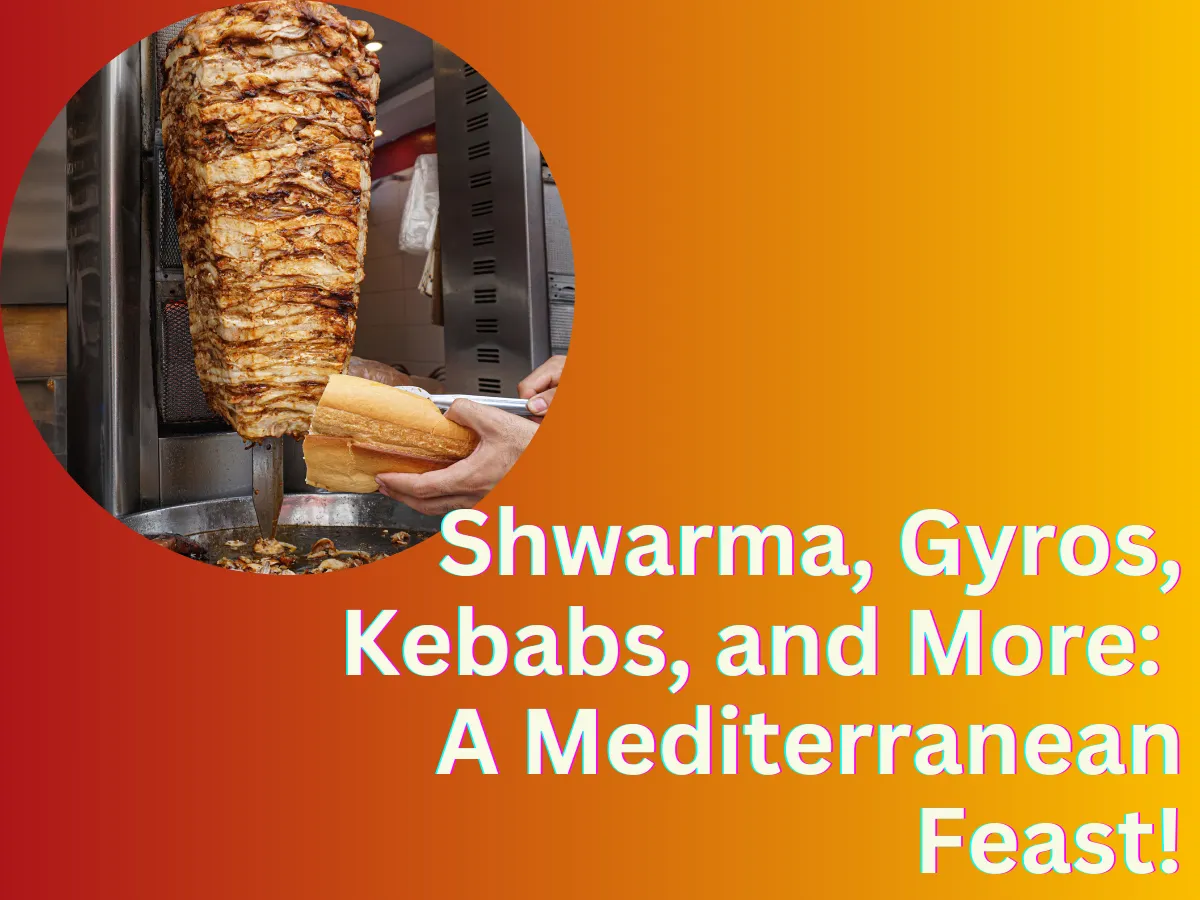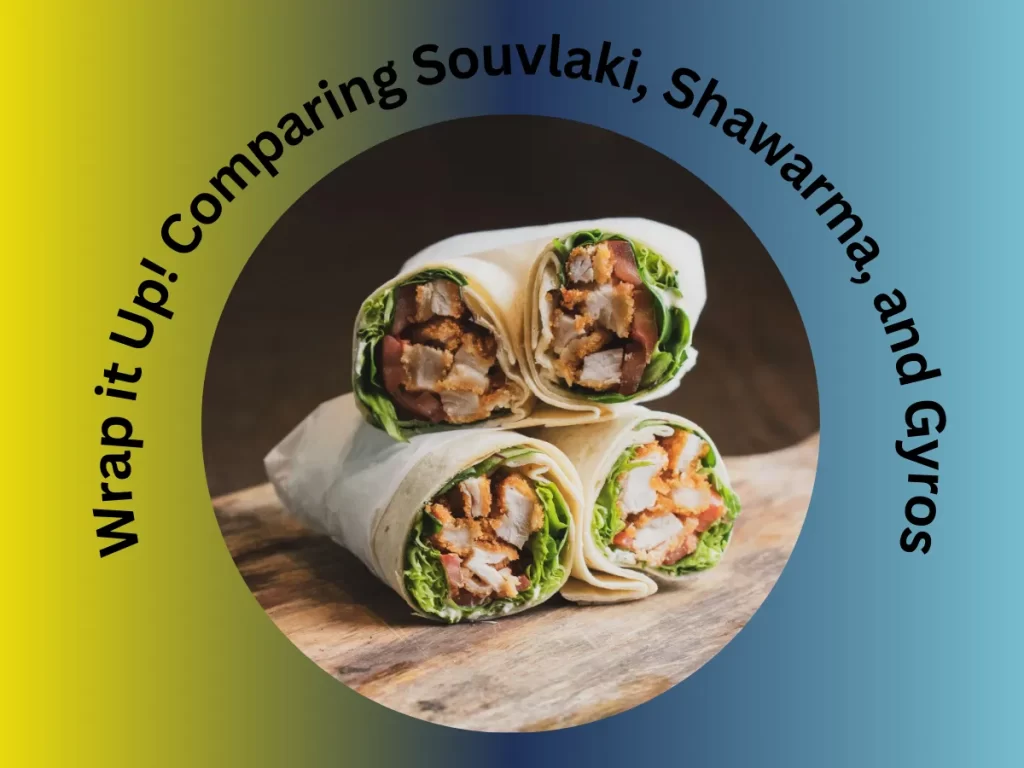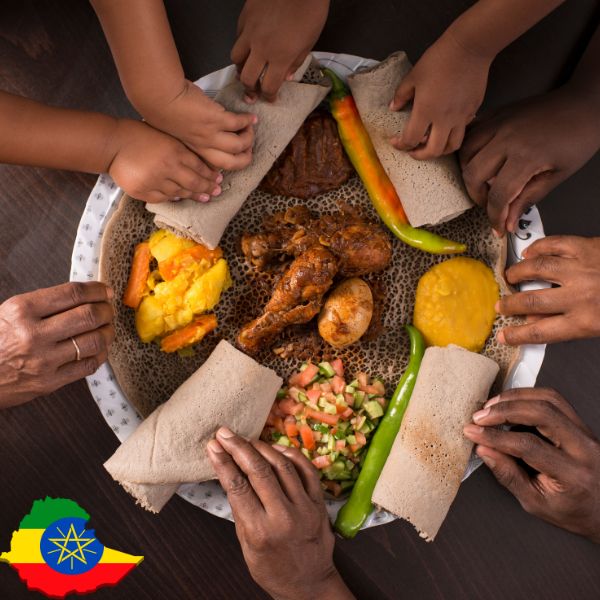Shawarma and Gyros, culinary delights that have captured people’s hearts and taste buds worldwide, boast a rich history and an even richer flavor profile.
When it comes to bold flavor, sizzling meat, and iconic street food, few dishes spark more delicious debate than shawarma and gyros. These Mediterranean favorites have captured hearts (and stomachs) across the globe, but what really sets them apart? Is it the spices, the cooking method, or the toppings that make shawarma and gyros so unforgettable?
In this ultimate grill-off, we’re diving deep into the smoky world of shawarma and gyros—exploring their origins, ingredients, and what makes each one a must-try for food lovers. Whether you’re a team shawarma or a loyal gyros fan, this tasty showdown is packed with flavor, facts, and plenty of mouthwatering inspiration.
Grilled, Stuffed, and Sauced: The Delicious World of Souvlaki, Kebab, Shawarma and Gyros
What is Shawarma?
- Origin: Shawarma traces its roots to the Middle East, particularly Lebanon, where it was traditionally prepared using marinated slices of beef, lamb, or chicken.
- Cooking Technique: Shawarma’s hallmark is its unique cooking method. Meat is stacked in a vertical rotisserie and slowly roasted as it turns, resulting in tender and flavorful slices.
- Seasonings: To infuse meat with flavor, it is marinated in aromatic spices such as cumin, coriander, paprika, and garlic. This marinade varies from region to region, imparting distinct regional nuances to the dish.
- Accompaniments: Shawarma is typically served with various accompaniments on a flatbread, such as pita or luffa. Depending on the region, these may include fresh vegetables, pickles, tahini sauce, and even French fries.
Shawarma Varieties
- Chicken Shawarma: Marinated chicken is a popular choice for shawarma. It’s often seasoned with herbs and spices and grilled to perfection.
- Beef Shawarma: Beef shawarma is known for its robust flavor. Thin slices of beef are layered on the rotisserie and cooked until tender.
- Lamb Shawarma: Lamb lovers savor the succulence of lamb shawarma. The meat’s distinctive taste pairs wonderfully with the spices and cooking techniques.
- Vegetarian Shawarma: In recent years, vegetarian and vegan shawarma options have gained popularity. These alternatives utilize ingredients such as falafel, tofu, or seitan as their primary protein source.
Global Shawarma Appeal
- The Middle East: Shawarma is a staple of Middle Eastern cuisine, enjoyed throughout the region. It’s often wrapped in flatbread with fresh vegetables and tahini sauce.
- Europe: European countries, particularly in the Mediterranean, have embraced shawarma. It is commonly found in Greece, known as “gyros,” and in Turkey as “döner kebab.”
- North America: Shawarma has become a staple in the hearts of North Americans, with shawarma restaurants and food trucks offering a diverse range of options and flavors.
- Asia: The popularity of shawarma is on the rise. It’s enjoyed in various forms, often fused with local flavors.
Shawarma: A Global Culinary Delight
- Food Fusion: Explore fusion shawarma options incorporating diverse culinary traditions, creating unique and delightful flavor combinations.
- Cultural Exchange: Shawarma’s global popularity showcases the beauty of culinary cultural exchange, where flavors from the Middle East have found a home in various corners of the world.
- Endless Variations: Shawarma’s versatility allows for infinite variations, ensuring a shawarma experience tailored to every palate.
In conclusion, shawarma is not just a dish; it’s a cultural phenomenon that has transcended borders and captivated the world with its delectable flavors and rich history. Whether you savor the classic flavors or embark on a culinary adventure with innovative variations, shawarma celebrates global gastronomy.
Mediterranean to Middle East: The Ultimate Guide to Iconic Street Wraps
The Difference between Souvlaki, Kebab, Gyros, and Shawarma
Many people typically refer to meat wrapped in flatbread as shawarma. Once you visit the nearest gyro spot and check their menu, you will see several options: gyros, kebab, shawarma, and souvlaki. Now, you are confused.
You might be tempted to exit casually, but there is no need. After reading this article, you will become familiar with the various flatbread dishes. Here are some of them:
What Is a Souvlaki?
Greek Souvlaki is a traditional Greek dish primarily made from pork, poultry, or beef. It is wrapped in pita bread or flatbread and then cooked on a skewer or grill. You can consume it with your hands and dip it in tzatziki.
Souvlaki is also known as Greek fast food. It is delicious and easy to make, and many people love it because it can be consumed quickly. It is also widely available in the US.
You can also try the souvlaki recipe at home. Souvlaki is available in most restaurants and is often featured on their special menus. Although it was mentioned that it comes with tzatziki, you will receive a yogurt-based sauce instead of mustard if you order chicken souvlaki.
What Is a Kebab?
You can also order this at a gyro spot and see if it’s similar. Kebabs are a popular dish consisting of skewered and grilled pieces of meat, often accompanied by vegetables or fruits. Commonly made with lamb, beef, chicken, or seafood, kebabs are seasoned with a variety of spices and marinades to enhance flavor.
Originating in the Middle East, kebabs have numerous regional variations, often served with rice, flatbreads, or salads. They are a flavorful, protein-packed meal option that can be customized to fit different dietary preferences, including vegetarian versions.
You will also get sauce with this. Most people prefer a yogurt and cucumber sauce. Aside from the sauce, you will also get lettuce, onion, and tomatoes for no additional cost.
The meaning of kebab is “to roast,” which is similar to its concept. For instance, you must roast the meat before throwing it in the pita bread and serving it.
What Are Gyros?
A Greek sandwich made of beef or lamb served in pita bread. Kebabs and gyros share similar ingredients and are served similarly. The only difference is in the type of meat. A gyro’s meat is usually beef or lamb, while kebabs are typically made from chicken or beef. They are also served snacks in Greece or fast food in the US.
Gyros are also popular because of their unique taste and ease of preparation. It is one of the most famous Greek fast foods in the world.
| Dish | Calories (per 100g) | Protein | Fat | Carbs | Fiber | Sodium | Common Ingredients |
|---|---|---|---|---|---|---|---|
| Shawarma | 250-300 | 20g | 15g | 10g | 1g | 500-800mg | Lamb or chicken, garlic, yogurt, spices, pita |
| Souvlaki | 200-250 | 22g | 12g | 5g | 1g | 300-500mg | Pork, chicken, olive oil, lemon, herbs |
| Kebabs | 150-250 | 20g | 12g | 8g | 1g | 400-700mg | Lamb, beef, chicken, vegetables, spices |
| Gyros | 250-300 | 21g | 15g | 9g | 2g | 600-900mg | Pork, chicken, lamb, tomatoes, onion, pita |
Vegan Alternatives: Shawarma and Gyros & Kebabas
Vegan alternatives to shawarma and gyros & kebabs offer a plant-based option that mimics the flavors and textures of traditional dishes while being cruelty-free and often healthier. These alternatives utilize plant-based proteins and vegetables as meat substitutes, creating satisfying meals that do not compromise on taste. Here are some vegan options:
Vegan Kebab Alternatives
Grilled Tofu Kebabs
Description: Firm tofu is marinated in olive oil, lemon juice, garlic, and spices such as cumin, paprika, and turmeric, then grilled or skewered. Tofu takes on a smoky, savory flavor and has a slightly crispy texture when grilled.
Serving Suggestions: Serve with a side of couscous, quinoa, or flatbread, along with fresh vegetables like bell peppers, onions, and zucchini.
Seitan Kebabs
Description: Seitan, also known as wheat meat, is a high-protein, chewy alternative that mimics the texture of meat. Marinate seitan in Mediterranean spices like oregano, garlic, and thyme, then skewer and grill for a hearty, flavorful kebab.
Serving Suggestion: Pair with hummus, tabbouleh, or a cucumber and tomato salad.
Jackfruit Kebabs
Description: Young jackfruit, which has a texture similar to shredded meat, can be marinated with spices like paprika, garlic, and chili, and then grilled. The jackfruit absorbs the flavors and develops a tender texture after cooking.
Serving Suggestion: Serve in pita bread or a wrap, topped with tahini or a yogurt-based sauce.
Chickpea and Vegetable Kebabs
Description: A hearty and straightforward option made by skewering marinated chickpeas with vegetables like onions, tomatoes, mushrooms, and peppers. These kebabs can be seasoned with a mix of herbs and spices.
Serving Suggestion: Serve with a drizzle of vegan tzatziki or a spicy harissa sauce.
Vegan Shawarma Alternatives
Jackfruit Shawarma
Description: Young jackfruit can be seasoned with shawarma spices such as cumin, coriander, turmeric, and garlic, then roasted to achieve a tender, shredded texture similar to meat. It can be served in a flatbread or pita, just like traditional shawarma.
Serving Suggestions: Serve with vegan garlic sauce, cucumber, tomatoes, and pickled vegetables.
Vegan “Chicken” Shawarma (using Soy or Seitan)
Description: For a soy-based shawarma, marinate soy curls or seitan in shawarma-style spices, such as paprika, cinnamon, garlic, and turmeric, then bake or fry until crispy. This will give the “meat” a chewy, flavorful texture.
Serving Suggestion: Serve in pita bread or flatbread, accompanied by tahini sauce, lettuce, and fresh herbs.
Roasted Cauliflower Shawarma
Description: Roasted cauliflower florets, marinated in shawarma spices and roasted until crispy, make a delicious and healthy alternative. The cauliflower absorbs the flavors of the marinade and has a hearty, satisfying texture.
Serving Suggestion: Serve in a warm pita with fresh tomatoes, cucumbers, and tahini dressing for a vibrant, plant-based shawarma experience.
Lentil Shawarma
Description: Cooked lentils are seasoned with shawarma spices, then mixed with sautéed onions, garlic, and tomatoes. This mixture is wrapped in a pita for a protein-packed, savory alternative to meat-based shawarma.
Serving Suggestion: Top with vegan yogurt or tahini sauce, and add some fresh herbs like parsley and mint.
Additional Vegan Shawarma and Gyros & Kebab Sauces
Vegan Tzatziki Sauce: A tangy, creamy sauce made with dairy-free yogurt, cucumber, garlic, lemon juice, and dill. Perfect for drizzling over kebabs or shawarma wraps.
Tahini Sauce: A rich and creamy sauce made from ground sesame seeds, lemon juice, garlic, and water. It adds a smooth, nutty flavor to any dish.
Vegan Garlic Sauce: A creamy, garlicky sauce made from cashews or vegan mayo, perfect for drizzling over your vegan shawarma or kebabs for extra flavor.
Conclusion
Vegan alternatives to shawarma, gyros, and kebabs provide a delicious and satisfying way to enjoy the flavors of traditional dishes without the use of meat. With plant-based proteins like tofu, seitan, jackfruit, and chickpeas, you can easily replicate the savory, spiced flavors of these Mediterranean and Middle Eastern favorites while keeping them nutritious and cruelty-free. Experiment with different spices and toppings to create the perfect vegan kebab or shawarma that suits your taste preferences!
Exploring plant-based options doesn’t mean giving up on the bold, savory flavors of your favorite Mediterranean dishes. Whether you’re a seasoned vegan or just looking to add more plant-based meals to your week, vegan alternatives to shawarma and gyros offer satisfying, flavorful experiences that stay true to the heart of Mediterranean cuisine. By using wholesome ingredients like jackfruit, seitan, tofu, and lentils, you can recreate the rich textures and spices that make shawarma and gyros so beloved.
Embrace the versatility of vegan cooking and enjoy these delicious, cruelty-free takes on shawarma and gyros—proof that healthy, ethical eating can be both full of flavor and rich in tradition.

.webp)






